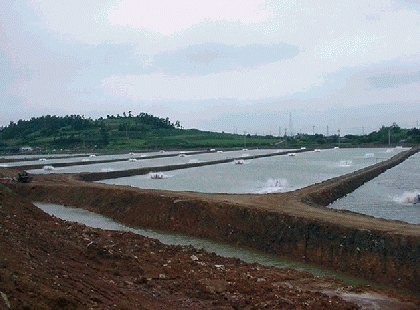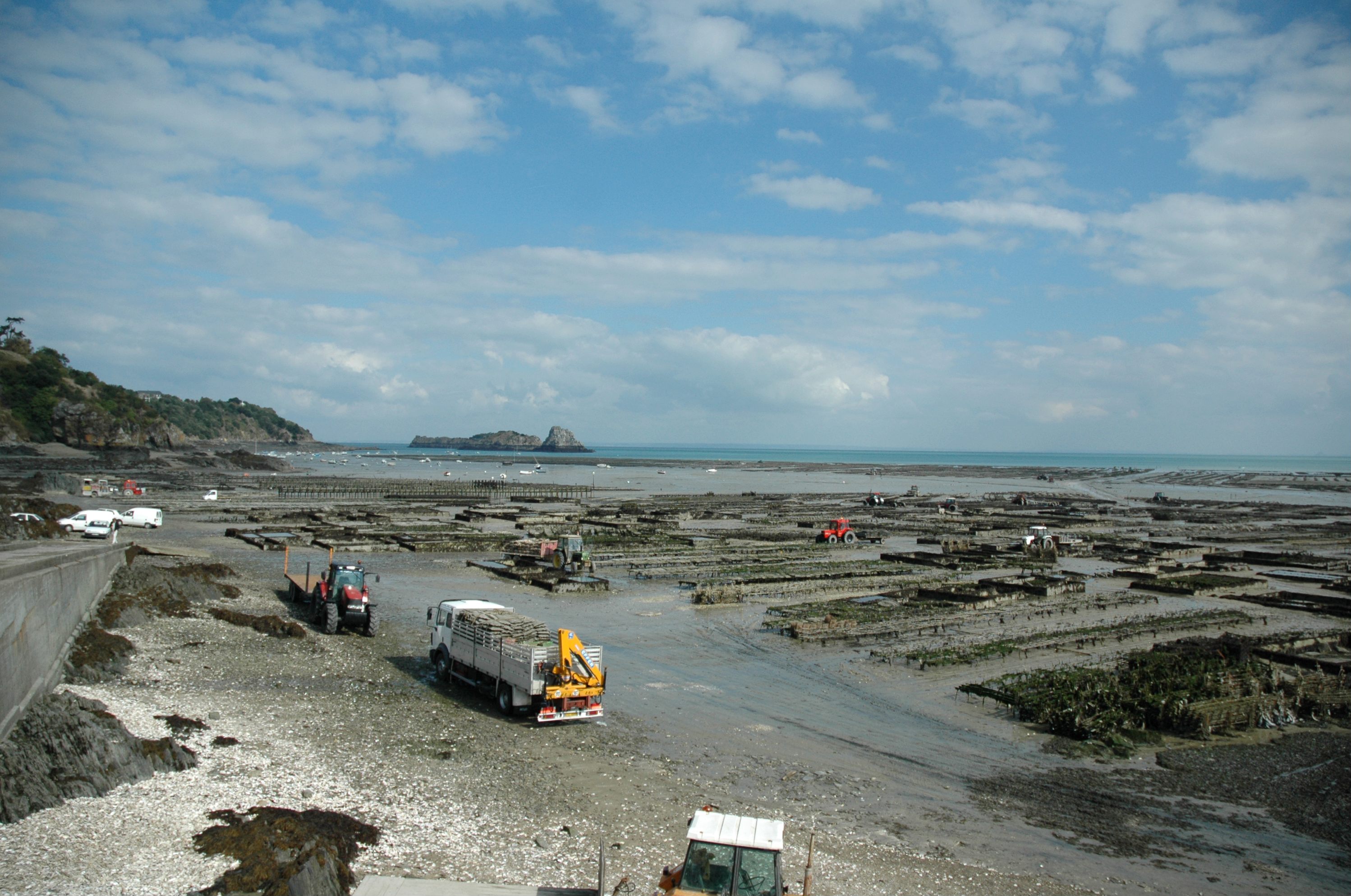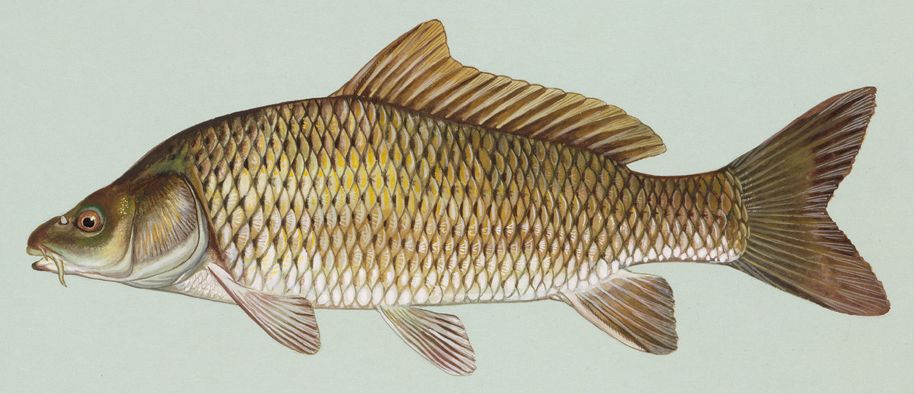|
Shijing River
The Shijing River () is a small river in Fujian Province of China. The tidal estuary it forms when entering the Weitou Bay of the Taiwan Strait is known as the Anhai Bay (). Most of the Shijing River's basin is within the Prefecture-level city of Quanzhou. Sources The sources of the Shijing River are in the hilly area near the border of Quanzhou's Nan'an City and Xiamen's Xiang'an District. The Shibi Reservoir (石壁水库; dam at ) constructed in 1955-1958 on the upper course of the Daying Stream () (one of the Shijing's tributaries) is used for irrigation and water supply in several towns within the county-level cities of Nan'an and Jinjiang. The reservoir also has a 1 MW hydroelectric plant. The lower course The lower course of the Shijing River, and the Anhai Bay, form the border between Quanzhou's two county-level units: Nan'an City in the west and Jinjiang City in the east. The riverside towns on the west (Nan'an) bank are Shuitou and Shijing, and on the east (Jinj ... [...More Info...] [...Related Items...] OR: [Wikipedia] [Google] [Baidu] |
Anhai Bay - DSCF9134
Anhai is a Towns of the People's Republic of China, town in southern Fujian province, People's Republic of China. It is located in the far southern suburbs of the Quanzhou metropolitan area. and is separated by Weitou Bay () from Kinmen, which is controlled by the Taiwan, Republic of China on Taiwan. Administratively, Anhai is part of Jinjiang, Fujian, Jinjiang County-level City, which in its turn is subordinated to Quanzhou. The highest point in the town's administrative area is Mount Língyuán () at . History Anhai was known as Anping () during the Song dynasty. The famous Song-era Anping Bridge crosses a tidal estuary to the west of town, connecting Anhai with its western neighbor, the town of Shuitou, Fujian, Shuitou, which administratively belongs in Nan'an, Fujian, Nan'an. Shuixin Chan Buddhism, Chan Temple is located by the eastern end of the bridge. Anhai was an important port during the Ming and early Qing periods. The 19th-century researchers writing for the Hakluyt ... [...More Info...] [...Related Items...] OR: [Wikipedia] [Google] [Baidu] |
Dongshi, Fujian
Dongshi Town (China) () is a township-level division of Jinjiang County-level city, which in its turn is a part of Quanzhou Prefecture-level city in Fujian Province, China. Dongshi is located on the eastern side of the Anhai Bay, which is the estuary formed by the Shijing River as it flows into the Taiwan Strait. See also *List of township-level divisions of Fujian This is a list of township-level divisions of the province of Fujian, People's Republic of China (PRC). After province, prefecture, and county-level divisions, township-level divisions constitute the formal fourth-level administrative divisio ... References Township-level divisions of Fujian Jinjiang, Fujian {{Fujian-geo-stub ... [...More Info...] [...Related Items...] OR: [Wikipedia] [Google] [Baidu] |
Shrimp Farming
Shrimp farming is an aquaculture business that exists in either a marine or freshwater environment, producing shrimp or prawns (crustaceans of the groups Caridea or Dendrobranchiata) for human consumption. Marine Commercial marine shrimp farming began in the 1970s, and production grew steeply, particularly to match the market demands of the United States, Japan, and Western Europe. The total global production of farmed shrimp reached more than 2.1 million tonnes in 1991, representing a value of nearly US$9 billion. About 30% of farmed shrimp is produced in Asia, particularly in China and Indonesia. The other 54.1% is produced mainly in Latin America, where Brazil, Ecuador, and Mexico are the largest producers. The largest exporting nation is Indonesia. Shrimp farming has changed from traditional, small-scale businesses in Southeast Asia into a global industry. Technological advances have led to growing shrimp at ever higher densities, and broodstock is shipped worldwide. Virt ... [...More Info...] [...Related Items...] OR: [Wikipedia] [Google] [Baidu] |
Oyster Farming
Oyster farming is an aquaculture (or mariculture) practice in which oysters are bred and raised mainly for their pearls, shells and inner organ tissue, which is eaten. Oyster farming was practiced by the ancient Romans as early as the 1st century BC on the Italian peninsula and later in Britain for export to Rome. The French oyster industry has relied on aquacultured oysters since the late 18th century. History Oyster farming was practiced by the ancient Romans as early as the 1st century BC on the Italian peninsula. With the Barbarian invasions the oyster farming in the Mediterranean and the Atlantic came to an end. In fact, the Romans were the very first to cultivate Oysters. The Roman engineer Sergius Orata is known for his innovative ways of breeding and commercializing oysters. He did this by cultivating the mollusk with a system that could control the water levels. In 1852 Monsieur de Bon started to re-seed the oyster beds by collecting the oyster spawn using m ... [...More Info...] [...Related Items...] OR: [Wikipedia] [Google] [Baidu] |
Sinonovacula Constricta
''Sinonovacula constricta'', the constricted tagelus, Chinese razor clam or Agemaki clam, is a commercially important species of bivalve native to the estuaries and mudflats of China and Japan. It is extensively Aquafarming, aquafarmed in China and other countries, with 742,084 tons worth US$667,876,000 harvested in 2008. Clams from Duotou village in Putian city, Fujian are particularly famous, and are a key ingredient in Putian cuisine. References {{Taxonbar, from1=Q11128398 Pharidae Bivalves described in 1818 Taxa named by Jean-Baptiste Lamarck ... [...More Info...] [...Related Items...] OR: [Wikipedia] [Google] [Baidu] |
Tegillarca Granosa
''Tegillarca granosa'' (also known as ''Anadara granosa'') is a species of ark clam known as the blood cockle or blood clam due to the red haemoglobin liquid inside the soft tissues. It is found throughout the Indo-Pacific region from the eastern coast of South Africa northwards and eastwards to Southeast Asia, Australia, Polynesia, and up to northern Japan. It lives mainly in the intertidal zone at one to two metres water depth, burrowed down into sand or mud. Adult size is about 5 to 6 cm long and 4 to 5 cm wide. Right and left valve of the same specimen: File:Tegillarca granosa 01.jpg, Right valve File:Tegillarca granosa 02.jpg, Left valve It has a high economic value as food, and it is kept in aquaculture. On the coast of Zhejiang Province alone, blood cockle plantations occupy around 145,000 '' mu'' (about 100 km2) of mudflats. These clams are raised in the river estuaries of the neighboring Fujian Province as well. Ruǎn Jīnshān; Li Xiùzhū; Lín K� ... [...More Info...] [...Related Items...] OR: [Wikipedia] [Google] [Baidu] |
Hectare
The hectare (; SI symbol: ha) is a non-SI metric unit of area equal to a square with 100- metre sides (1 hm2), or 10,000 m2, and is primarily used in the measurement of land. There are 100 hectares in one square kilometre. An acre is about and one hectare contains about . In 1795, when the metric system was introduced, the ''are'' was defined as 100 square metres, or one square decametre, and the hectare (" hecto-" + "are") was thus 100 ''ares'' or km2 (10,000 square metres). When the metric system was further rationalised in 1960, resulting in the International System of Units (), the ''are'' was not included as a recognised unit. The hectare, however, remains as a non-SI unit accepted for use with the SI and whose use is "expected to continue indefinitely". Though the dekare/decare daa (1,000 m2) and are (100 m2) are not officially "accepted for use", they are still used in some contexts. Description The hectare (), although not a unit of SI, ... [...More Info...] [...Related Items...] OR: [Wikipedia] [Google] [Baidu] |
Aquaculture In China
China, with one-fifth of the world's population, accounts for two-thirds of the world's reported aquaculture production.FAO Fact sheetAquaculture in China and Asia/ref> Aquaculture is the farming of fish and other aquatic life in enclosures, such as ponds, lakes and tanks, or cages in rivers and coastal waters. China's 2005 reported harvest was 32.4 million tonnes, more than 10 times that of the second-ranked nation, India, which reported 2.8 million tonnes. China's 2005 reported catch of wild fish, caught in rivers, lakes, and the sea, was 17.1 million tonnes. This means that aquaculture accounts for nearly two-thirds of China's reported total output. The principal aquaculture-producing regions are close to urban markets in the middle and lower Yangtze valley and the Zhu Jiang delta. Early history Aquaculture began about 3500 BC in China with the farming of the common carp. These carp were grown in ponds on silk farms, and were fed silkworm nymphs and faeces.Parker R (2000'' ... [...More Info...] [...Related Items...] OR: [Wikipedia] [Google] [Baidu] |
Anhai Bay - DSCF8845
Anhai is a town in southern Fujian province, People's Republic of China. It is located in the far southern suburbs of the Quanzhou metropolitan area. and is separated by Weitou Bay () from Kinmen, which is controlled by the Republic of China on Taiwan. Administratively, Anhai is part of Jinjiang County-level City, which in its turn is subordinated to Quanzhou. The highest point in the town's administrative area is Mount Língyuán () at . History Anhai was known as Anping () during the Song dynasty. The famous Song-era Anping Bridge crosses a tidal estuary to the west of town, connecting Anhai with its western neighbor, the town of Shuitou, which administratively belongs in Nan'an. Shuixin Chan Temple is located by the eastern end of the bridge. Anhai was an important port during the Ming and early Qing periods. The 19th-century researchers writing for the Hakluyt Society thought Anhai was the port of "Tansuso" visited by Martín de Rada, but later research identified T ... [...More Info...] [...Related Items...] OR: [Wikipedia] [Google] [Baidu] |
Anping Bridge
Anping Bridge () is a Song dynasty stone beam bridge in Fujian province. It is long. Fu et al (2002), p. 185 Mao (1978), p. 6 The bridge is also known as the Wuli Bridge (, literally ''Five Li Bridge'') because its length is about 5 '' li'', where a ''li'' is about 500 meters or 0.3 miles. Ministry of Culture of the People's Republic of China (2003) It is a nationally protected historic site registered with the National Cultural Heritage Administration. The bridge lies in the prefecture-level city of Quanzhou, crossing what originally was a tidal estuary of the Shijing River that separates the town of Anhai (in the county-level city of Jinjiang) east of the river, from the town of Shuitou (in the county-level city of Nan'an) west of the river. The bridge is named after Anhai, which was formerly known as Anping. Anping Bridge consists of 331 spans of granite beams resting on top of stone piers, the largest beam weighing 25 tons. The width of the bridge varies from . It origin ... [...More Info...] [...Related Items...] OR: [Wikipedia] [Google] [Baidu] |



.jpg)

